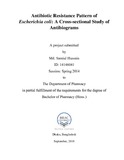| dc.description.abstract | Antibiotic resistance is one of the serious issues nowadays. This is a global problem and more problematic in developing and underdeveloped countries. It develops due to various reasons, like food habit, poor sanitization, improper prescribing method, taking antibiotics without prescription or any kind of consultation with doctor, and uncontrolled antibiotic use for fisheries, poultry and veterinary and for the lack of knowledge of antibiotic use. In case of resistance mechanism, it follows several ways such as change of cell wall, target modification, antibiotic inactivation, efflux pump out, ribosome protection and biofilm formation. In this research, culture and sensitivity test reports were collected from the microbiology department of a renowned diagnostic center, and all the antibiogram is about Escherichia coli sensitivity. In case data of analysis, the reports were analyzed by gender, age group, and divisions. Out of 543 antibiogram reports, most sensitive antibiotics were amikacin, ampicillin, amoxyclav, cefotaxim, cefexime, ceftriaxone, ciprofloxacin, colisitin, gentamycin, imipenem, meropenem, nitrofuration and tigecycline up to 95%. Most resistant antibiotics were azithromycin, aztreonam, cefuroxime, ceftriaxone, cephradine, nalidixic acid, levofloxacin, cefoxitin and tetracycline (60-90%). Here, mostly susceptible age grouped peoples are under 30 years and elderly peoples in some cases. Among the 28 antibiotics, 9 were analyzed with significance where no mortality was found but the statistical significancefor 31-45 years age group was evident with an odds ratio (OR) 3.42 (95%CI; 1.60±7.32; p= 0.002) and for ≥46 years (OR22.47, 95%CI; 1063±47.47; p= <0.001) for amoxyclav. Cefexime is more significant in case of resistance compared to sensitivefor 31-45 years age group (OR1.08, 5%CI; 0.40±2.89; p= 0.883) and for ≥46 years (OR1.41; 95%CI; 0.40±2.89; p= .554). In case of doxycycline 31-45 year age group (OR1.43; 95%CI; 0.59±3.53) and for more than 46 years age group (OR1.41; 95%CI; 0.57±3.53; p= 4.63). Lastly, for tigecycline 31-45 years age group (OR 0.45; 95%CI; 0.29±0.68; p= <0.001) and for more than 46 years age group (OR0.27; 95%CI; 0.17±0.44; p= <0.001) which is less significant. Escherichia coli is very common and can be contaminated very easily so people of all ages and divisions should be more careful regarding antibiotics intake to control the increasing antibiotic resistance. | en_US |

